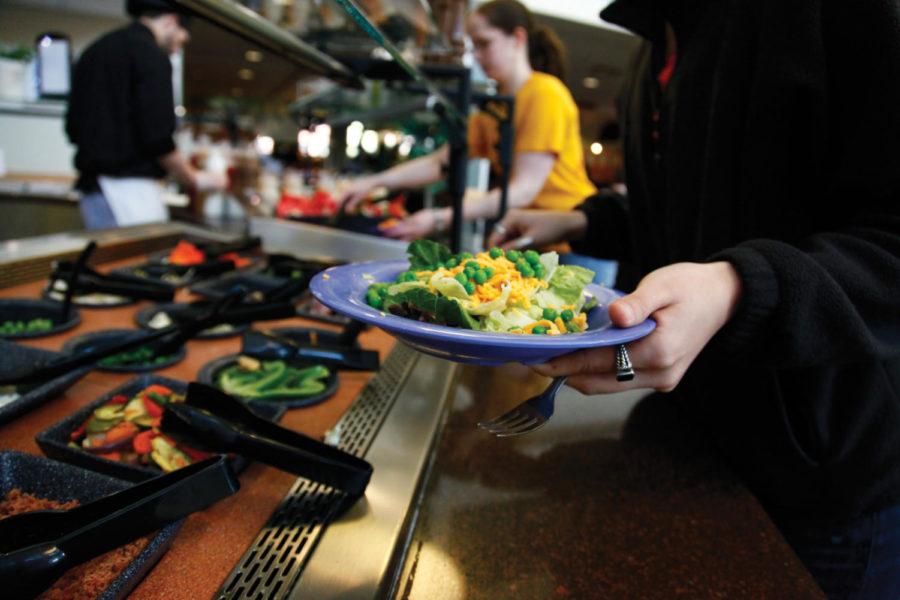Campus food travels thousands of miles to reach students
Photo: Clark Colby/Iowa State Daily
Healthy Food (copy)
March 10, 2015
As you enjoy lunch at one of the 21 dining locations on campus, do you ever find yourself wondering how your food got there? How long did it take for the bag of chips that you are eating to get to the Memorial Union Food Court?
Students like Brandon Wetterberg, sophomore in aerospace engineering, don’t give much thought to where their food comes from before they put it on their plate. However, Karen Rodekamp is responsible for where food comes from in order to feed ISU students.
Rodekamp is the food stores manager for ISU Dining and she places food and drink orders five days a week for each dining location and convenience store on campus. Rodekamp’s food orders are placed with local growers or companies in Kansas City, Kan., Des Moines and Cedar Falls, and are delivered every Monday through Friday.
“I purchase 300 commodity items, sauces, beans, spices and canned and bottled soda product,” Rodekamp said.
Martin Bros. Distributing, located in Cedar Falls, makes two trips to Ames every Monday through Friday. The drive is approximately 188 miles round trip. In one week, the distributing company travels approximately 1,880 miles.
Wetterberg said he shops for groceries once a month.
When he shops, he tends to shop at chain stores like Walmart and Target, instead of a farmers market.
“[I] just mainly [buy] snack foods like mac ‘n cheese, chips and stuff like that,” Wetterberg said.
Rodekamp said Iowa State has been buying items such as tomatoes, peppers and honey locally for 10 years. Farm to ISU was developed in 2006. The program works to encompass local growers and supports farms in the state of Iowa.
“We’re promoting jobs and that dollar is staying in the state,” Rodekamp said. “For local [buying], there are several facets supporting the local growers but then there’s local for the items that are manufactured in the state of Iowa.”
Wetterberg said he would consider shopping and buying locally if he knew it would benefit the state of Iowa.
Rodekamp said some of her purchasing decisions are made based on whether she can get the same product from an Iowa-based company as she would from a company outside of Iowa.
Feediowa1st.com is working to bring attention to food insecurity in Iowa. According to the website, food travels an average of 1,700 miles to reach an Iowan’s plate and more than 90 percent of food in Iowa is imported.
Craig Chase works with the Leopold Center and said buying local can aid in tracing a food item back to a specific farm in case of a food recall.
“If you’re buying [directly] from a farmers market or a restaurant, if something happens, the traceability goes right back to that farm,” Chase said.
Rodekamp said Iowa’s growing and feeding systems don’t align perfectly, which makes it difficult for ISU Dining to buy locally the entire time.
“We get a six-week window to buy local produce unless it’s a cold-store item,” Rodekamp said.
Although ISU Dining often buys local, certain food products like pineapple cannot be grown locally. To get foods like pineapple to Iowa State, Rodekamp must order from one of her distributors in Kansas City, Kan., Cedar Falls or Des Moines. In order for food to get to the distributors that Rodekamp works with, it has to arrive in the United States first. Chase said food typically comes to the United States on ship containers. Upon arrival, the food is inspected and then put on trucks and railcars for distribution across the country.
“Naturally, we don’t produce enough food to feed ourselves,” Chase said. “We get lots of fruit and vegetables from Chile.”
While tracing food back to local farms is easy, it’s just the opposite when food is brought to the United States from other places. Food inspectors are responsible for making sure that production standards in the country the food is coming from are similar to those in the United States and that no unregistered pesticide products were used on the food.
“Food inspectors at the ports make sure that what’s coming in is what they say is coming in [and that it’s a] safe product,” Chase said.

















